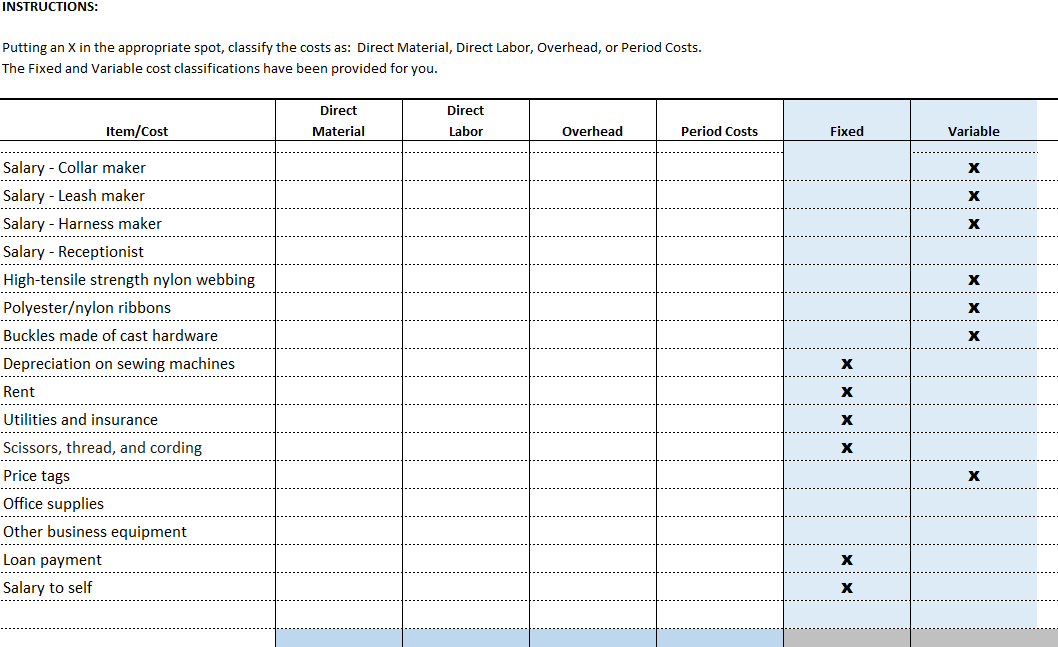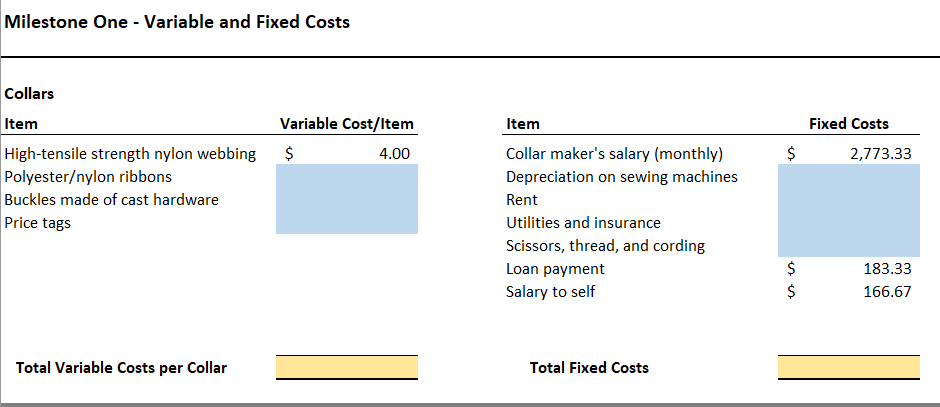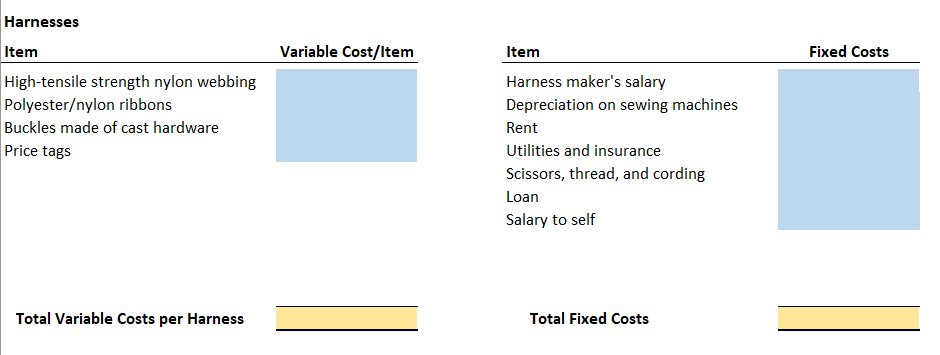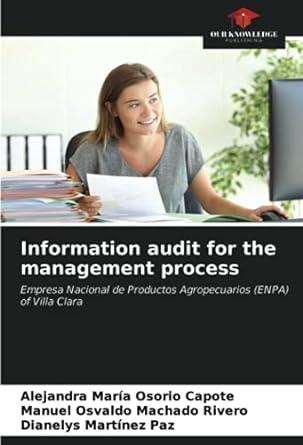Question
Overview Successful entrepreneurs understand all aspects of business, especially costs and costing systems. In the course project, you will assume the role of the owner
Overview
Successful entrepreneurs understand all aspects of business, especially costs and costing systems. In the course project, you will assume the role of the owner of a small business and apply managerial accounting principles to evaluate and manage costs related to your services within a costing system. In the first milestone of the project, you will determine and classify the costs necessary for opening your business.
Scenario
You plan to open a business manufacturing collars, leashes, and harnesses for pets. To begin, you will manufacture these in a standard style and size with plans to expand your range over the year. In a few weeks, you will present your companys financial strategy to some key investors. To begin creating your strategy, you need to consider and record all the costs associated with operating your business. You have decided to use the job order costing system.
Prompt
Use the given operational costs in theMilestone One Operational Costs Data Appendix (see Doc 1 below)to complete the first two tabs, Cost Classification and Variable and Fixed Costs, in theProject Workbook Spreadsheet. (See Doc 2 below)
Specifically, you must address the following rubric criteria:
- Cost Classification.Accurately classify all your costs in the Cost Classification tab of your workbook.
- Identify direct material, direct labor, overhead, and period costs. (Note: Fixed and variable costs have been classified for you.)
- Variable and Fixed Costs.Complete the Variable and Fixed Costs tab of your workbook. (Note: Some costs are provided for you. Fill in only the missing costs.)
- Determine your total variable cost per unit and the total fixed costs for each product. Show your work using calculations to the side of the table or using appropriate formulas in the table.
Doc 1:
You plan to open a small business for manufacturing pet collars, leashes, and harnesses. You have found a workshop space you can use for sewing your products. After some research and planning, you have estimates for the various operating costs for your business.
The total square footage for the sewing rooms is 1,500 square feet broken into three areas (500 square feet each). You have taken out a loan for start-up costs, and the monthly payment is $550; it goes into effect immediately and should be accounted for in your costs. You will also collect a modest salary for the first year of $500 per month; remember to divide evenly among the services.
Salary and Hiring Data
- One collar maker, who will be paid $16.00 per hour and work 40 hours per week
- One leash maker, who will be paid $16.00 per hour and work 40 hours per week
- One harness maker, who will be paid $17.00 per hour and work 40 hours per week
- One receptionist, who will be paid $15.00 per hour and work 30 hours per week
Other Costs
- Rent: $750 per month; allocate based on square footage
- High-tensile strength nylon webbing$12 per yard of webbing
- 3 collars per yard of webbing
- 2 leashes per yard of webbing
- 2 harnesses per yard of webbing
- Polyesterylon ribbons$9 per yard of ribbon
- 3 collars per yard of ribbon
- 2 leashes per yard of ribbon
- 2 harnesses per yard of ribbon
- Buckles made of cast hardware$0.50 per buckle
- 4 buckles used per collar
- 3 buckles used per leash
- 8 buckles used per harness
- 3 industrial sewing machines at $3,300 each for a total of $9,900; depreciation is $165 per month (5-year life, zero salvage value)
- Utilities and insurance: $600 per month; allocate based on square footage
- Scissors, thread, cording: $1,200
- Price tags: $250 for 2,500 ($0.10 each)
- Office supplies: $2,400 or $200 per month
- Other business equipment: $2,000
- Loan payment of $550 per month
- Salary drawn of $500 per month
DOC 2:
Cost Classification

VARIABLE AND FIXED COST


 Putting an X in the appropriate spot, classify the costs as: Direct Material, Direct Labor, Overhead, or Period Costs. The Fixed and Variable cost classifications have been provided for you. Leashes Harnesses Item High-tensile strength nylon webbing Polyesterylon ribbons Buckles made of cast hardware Price tags Variable Cost/Item Item Harness maker's salary Depreciation on sewing machines Rent Utilities and insurance Scissors, thread, and cording Loan Salary to self Fixed Costs Fixed Costs Milestone One - Variable and Fixed Costs
Putting an X in the appropriate spot, classify the costs as: Direct Material, Direct Labor, Overhead, or Period Costs. The Fixed and Variable cost classifications have been provided for you. Leashes Harnesses Item High-tensile strength nylon webbing Polyesterylon ribbons Buckles made of cast hardware Price tags Variable Cost/Item Item Harness maker's salary Depreciation on sewing machines Rent Utilities and insurance Scissors, thread, and cording Loan Salary to self Fixed Costs Fixed Costs Milestone One - Variable and Fixed Costs Step by Step Solution
There are 3 Steps involved in it
Step: 1

Get Instant Access to Expert-Tailored Solutions
See step-by-step solutions with expert insights and AI powered tools for academic success
Step: 2

Step: 3

Ace Your Homework with AI
Get the answers you need in no time with our AI-driven, step-by-step assistance
Get Started


